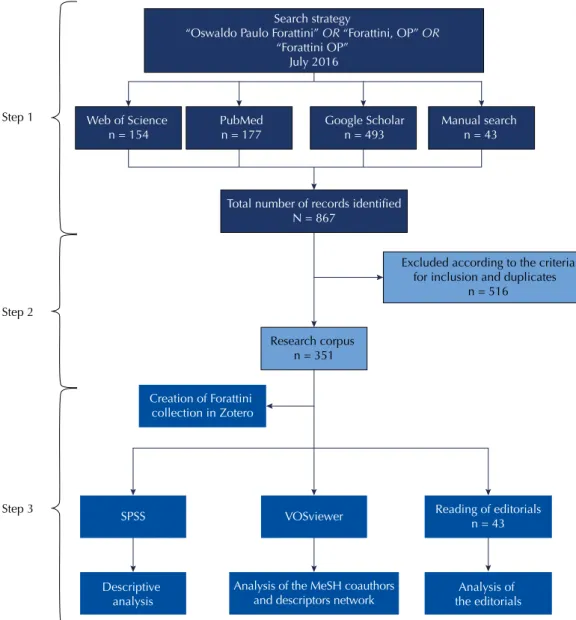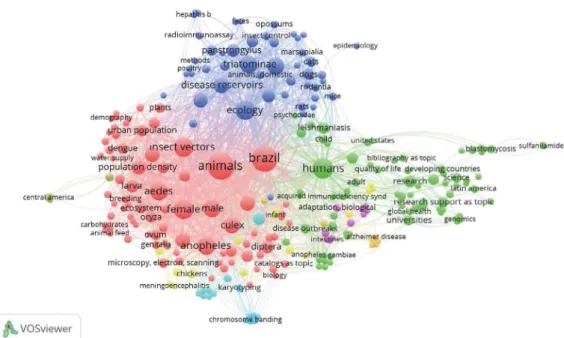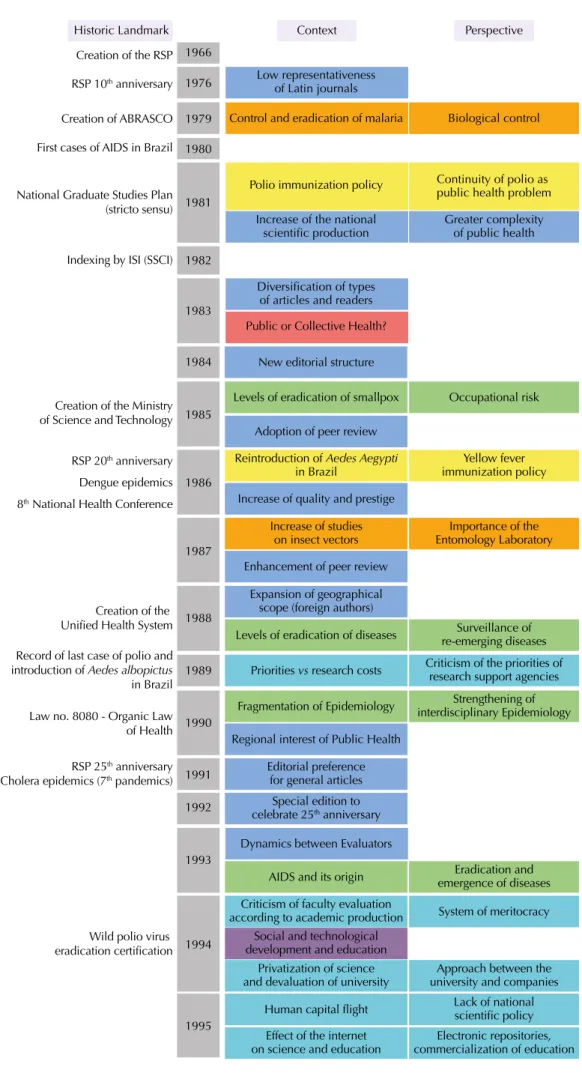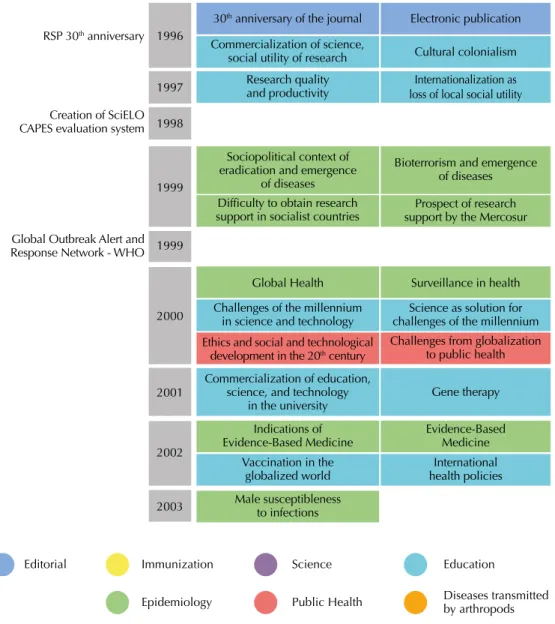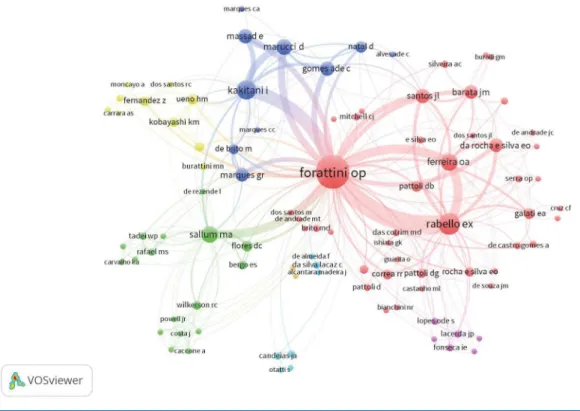Contribution of Oswaldo Paulo Forattini
to public health: analysis of
scientific production
Juliana Gonçalves ReisI, Keilla Miki KobayashiII, Helene Mariko UenoIII, Cristiane Martins RibeiroIV,
Telma Abdalla de Oliveira CardosoIV
I Programa de Pós-Graduação Saúde Materno-infantil. Faculdade de Medicina. Universidade Federal
Fluminense. Niterói, RJ, Brasil
II Escola Politécnica de Saúde Joaquim Venâncio. Fundação Oswaldo Cruz. Rio de Janeiro, RJ, Brasil
III Programa de Pós-Graduação em Sustentabilidade. Escola de Artes, Ciências e Humanidades. Universidade de
São Paulo. São Paulo, SP, Brasil
IV Núcleo de Biossegurança. Escola Nacional Saúde Pública. Fundação Oswaldo Cruz. Rio de Janeiro, RJ, Brasil
ABSTRACT
OBJECTIVE: To analyze the main characteristics of the scientiic production of Oswaldo Paulo Forattini, researcher and, for 40 years, editor of Revista de Saúde Pública.
METHODS: Descriptive study with bibliometric approach conducted in three steps. (1) identiication of bibliographic records using the following search strategy: “Oswaldo Paulo Forattini” OR “Forattini OP” OR “Forattini” up information sources Google Scholar, Web of Science, and PubMed, in July 2016, which retrieved 867 records. (2) composition of research corpus, in which we included 351 bibliographic records of articles, books, book chapters, editorials, book reviews, informative notes and annual reports of the RSP and excluded 516 duplicates and acknowledgement notes, obituary notes, and nonretrievable citations. (3) data organization and analysis, in which we built databases for descriptive analysis and development of the MeSH coauthors and terms networks in VOSviewer software. For analysis of editorials, three reviewers read the full text of each editorial and categorized them according to subject, historical context and perspectives, relating them with historical milestones.
RESULTS: Forattini’s scientiic production occurred from 1946 to 2009, most consisting of articles (n = 218; 62.1%), editorials (n = 43; 12.3%), and books (n = 13; 3.7%). he main subjects were Culicidae (36.8%), Triatominae (12.5%), and Epidemiology (10.0%). he coauthors of articles were his professors, colleagues of his generation, and graduate students. His editorials addressed critical relections on the production of knowledge, research priorities, and factors that contributed to or hindered progress. he scope of subjects is broad, referring to socioeconomic and scientiic development, public health issues in developed countries, or global health.
CONCLUSIONS: he analysis shows Forattini’s commitment with public health, research with vectors, training of researchers, and scientiic communication.
DESCRIPTORS: Scientiic and Technical Activities. Entomology. Scientiic Communication and Difusion. Bibliometrics. Historical Article.
Correspondence:
Juliana Gonçalves Reis
Rua Parecis, 55 casa 1 Cosme Velho 22241-180 Rio de Janeiro, RJ, Brasil E-mail: julianareis20@gmail.com
Received: 23 Aug 2016
Approved: 26 Aug 2016
How to cite: Reis JG, Kobayashi KM, Ueno HM, Ribeiro CM, Cardoso TAO. Contribution of Oswaldo Paulo Forattini to public health: analysis of scientific production. Rev Saude Publica. 2016;50:73.
Copyright: This is an open-access article distributed under the terms of the Creative Commons Attribution License, which permits unrestricted use, distribution, and reproduction in any medium, provided that the original author and source are credited.
INTRODUCTION
To celebrate the 50 years anniversary of the Revista de Saúde Pública (RSP), we reviewed the scientiic production of Oswaldo Paulo Forattini. His publications and academic history have been reported in other articles13,15,16. Forattini graduated in Medicine from the Universidade
de São Paulo (USP) in 1949, was a professor of the Medical Entomology Program of the Faculdade de Saúde Pública of the Universidade de São Paulo (FSP-USP), and editor of the RSP for 40 years.
he RSP, published since 1967 by the FSP-USP replacing the Arquivos da Faculdade de Higiene e Saúde Pública, is established as one of the main scientiic journals of Brazil. Its mission is to publish original contributions on relevant issues in public health, in Portuguese, English, and Spanish. Its scope is national and international, since its irst volume published with indexing: Medline, PubMed, homson Reuters/ISI, Web of Science, Social Sciences Citation Index, Current Contents/Social Behavioral Science, Global Health, Biosis, Embase, HEALSAFE, POPline, Tropical Diseases Bulletin, Bulletin of Communicable Abstracts, Nutrition Abstracts & Reviews, and Wildlife Worldwide.
Considering the relevance of the RSP and Forattini’s activities in Public health, this study presents relections on the relations between his careers as researcher and editor and the construction and development of the scientiic ield. According to Bourdieu (1989), a ield emerges from practices of agents that constitute it, while the practices deine and inhibit the possible conducts of the agents1
. Hayashi (2014) points out that the social dimensions of scientiic activity, from the perspectives of the Sociology of Science and Social Studies of Science, establish relations with the theoretical framework of Bibliometrics and Scientometrics12.
With this article we aimed to analyze the main characteristics of the scientiic production of Oswaldo Paulo Forattini, researcher and, for 40 years, editor of the Revista de Saúde Pública.
METHODS
his is a descriptive study with Bibliometric approach. According to Hayashi12 (2014, p. 302),
“Bibliometrics and Scientometrics provide instruments to map and extract useful information to understand the social and intellectual structure of scientiic ields and the social, economic and political aspects involved in scientiic activity.”
The survey was conducted in three steps: (1) identification of bibliographic records; (2) composition of research corpus; (3) data organization and analysis (Figure 1).
For step 1 – identiication of bibliographic records – data collection was performed on the following information sources: Google Scholar, by creating the researcher’s proile in Scholar Google, Web of Science, and PubMed. Scholar Google presents greater scope in information retrieval. In addition to the peer-reviewed scientiic literature, other types of documents can be identiied, such as books and book chapters, as well as the number of citations. However, thorough curation is required to obtain quality data. he Web of Science is a multidisciplinary information source with higher quality bibliographic elements and PubMed is an open-access, healthcare-speciic information source.
he search strategy employed is presented in Figure 1. Manual search for editorials published in the RSP was also conducted. To identify all bibliographic records, there was no restriction concerning year of publication.
In step 3, data organization and analysis, we created a collection of bibliographic records identiied in the reference manager Zoteroa
. Two databases were built: the irst in the Statistical Package for the Social Sciences (SPSS) for descriptive analysis; the second for preparation of infographics of the coauthors and terms networks of the Medical Subject Headings (MeSH) in VOSviewer software of the the Centre for Science and Technology Studies (CWST).
hree reviewers analyzed the RSP editorials by fully reading each editorial signed by Forattini. he content was categorized according to subject, historical context, and perspectives and was related to historical milestones.
RESULTS AND DISCUSSION
he results are presented in table and pictures with their respective discussions. Until the completion of this article, on August 22, 2016, there were 6,840 citations retrieved in Google Scholarb.
Forattini’s scientiic production spanned six decades, the most fruitful from 1986 to 1995 with 24.0% of total documents. From 1946 to 1955, he published 37 articles, the irst ones
a The collection of articles by
Forattini in Zotero is available from: https://www.zotero.org/ groups/forattini
b Profile of Oswaldo Forattini at
Google Scholar. Available from: https://scholar.google.com.br/ citations?hl=pt-BR&user= MAYJRtYAAAAJ
SPSS: Statistical Package for the Social Sciences; MeSH: Medical Subject Headings * Each step is represented by a tone of blue.
Figure 1. Study steps flowchart*.
Search strategy
“Oswaldo Paulo Forattini” OR “Forattini, OP” OR
“Forattini OP” July 2016
Step 1
Step 2
Step 3
Web of Science n = 154
PubMed n = 177
Google Scholar n = 493
Manual search n = 43
Total number of records identified N = 867
Excluded according to the criteria for inclusion and duplicates
n = 516
Research corpus n = 351
Creation of Forattini collection in Zotero
SPSS VOSviewer Reading of editorials
n = 43
Descriptive analysis
Analysis of the MeSH coauthors and descriptors network
still as undergraduate student. He was the only author in ive of the 14 works published as a student, showing his proile as a pathological and clinical researcher.
From 1948, he began to publish in Entomology and, gradually, his publications were predominantly – but not exclusively – in this area. In the 1950s, researches emerged on taxonomy of Diptera and Triatominae in general and research on Bionomics of vectors or potential vectors of infectious and parasitic diseases. Often, the two lines supported description or redescription of vector species.
Noteworthy, he collaborated with the Special Health Service of Araraquara in 1949–1950, in the region of Ribeirão Preto, São Paulo, to clarify the possible existence of autochthonous schistosomiasis mansoni. In these researches, he found autochthonous focus of Chagas disease and leishmaniasis.
From 1950 to 1960, he studied leishmaniasis in the São Paulo state as a member of the Committee for the Study of Leishmaniasis of the State Department of Public Health and Social Assistance of São Paulo, but also in the states of Mato Grosso and Paraná, in addition to the then territories of Amapá and Rondônia. hese studies were an opportunity to associate medical entomology studies with the epidemiological context of transmission of infectious and parasitic diseases by using ield research.
hus, Forattini experienced contexts of disease transmission, determining transmission foci, reservoirs, potential vectors, and human behavior aspects that would justify such epidemiological situation. He continued the laboratory studies both on clinical indings in humans or reservoirs and on vector taxonomy and infectivity.
Based on these laboratory and ield researches, Forattini published a book series called Entomologia Médica2–5 (1962; 1965a, 1965b, 1973), assumed as a specialty in Public Health
and required for the study the epidemiology of diseases transmitted or determined by arthropods. His books addressed classiication and systematics of the groups (richly
Table. Historical series of scientific production of Oswaldo Paulo Forattini, second decade (1946-2009).
Variable
Historical series
1946-1955 1956-1965 1966-1975 1976-1985 1986-1995 1996-2005 2006-2009 Total
n % n % n % n % n % n % n % N %
Documents
identified 37 11.0 54 15.0 41 12.0 56 16.0 85 24.0 72 20.0 6 2.0 351 100
Type of document
Articles 29 78.4 45 83.3 24 58.5 29 51.8 45 52.9 42 58.3 6 100 220 62.7
Editorial - - - 9 16.1 17 20.0 17 23.6 - - 43 12.3
Book - - 3 5.6 1 2.4 1 1.8 1 1.2 7 9.7 - - 13 3.7
Book chapter - - - 2 3.6 1 1.2 - - - - 3 0.9
Notes 8 21.6 6 11.1 9 22.0 5 8.9 5 5.9 6 8.3 - - 39 11.1
Book review - - - - 7 17.1 8 14.3 14 16.5 - - - - 29 8.3
Event Annals - - - 1 1.8 - - - 1 0.3
RSP reports - - - 1 1.8 2 2.4 - - - - 3 0.9
Subject
Arbovirus - - 2 3.7 1 2.4 - - - - 1 1.4 - - 4 1.1
Ceratopogonidae 9 24.3 14 25.9 - - - 23 6.6
Culicidae 2 5.4 22 40.7 9 22.0 5 8.9 42 49.4 44 61.1 5 83.3 129 36.8
Ecology - - - 1 1.8 3 3.5 - - - - 4 1.1
Epidemiology - - 1 1.9 - - 11 19.6 14 16.5 9 12.5 - - 35 10.0
Leishmaniasis 4 10.8 6 11.1 5 12.2 1 1.8 - - - 16 4.6
Phlebotominae 5 13.5 4 7.4 5 12.2 2 3.6 - - - 16 4.6
Journal - - - 5 8.9 6 7.1 2 2.8 - - 13 3.7
Triatominae 2 5.4 1 1.9 14 34.1 26 46.4 - - - - 1 16.7 44 12.5
illustrated by himself), biological aspects, and epidemiology and prophylaxis of diseases involving arthropods. His Entomology books are essential for students and field researchers. In these books he described several identiication keys for species of diptera and Triatominae of interest in public health, which he designed with freehand drawing and ink in illustrative boards.
From 1976 to 1985, Forattini continued with research on leishmaniasis and Phlebotominae. In the same period, however, the encephalitis epidemic by Rocio virus in the Vale do Ribeira, São Paulo, led him to the region, where he began to study the potential vectors of this emerging arbovirosis. Again, the epidemiological characteristics of the transmission and of the people afected led him to formulate hypotheses about mosquito vectors and about the role of man in the increased risk of transmission of arboviruses. hese hypotheses were tested until the end of his career.
In the context of the Brazilian epidemiological transition, the emergence of modern diseases ( for example, chronic degenerative diseases, occupational and traic accidents) caused no change to his focus on researching the epidemiology of infectious and parasitic diseases, with emphasis on environmental factors – natural and anthropogenic – that favored the transmission of these diseases, including proliferation, adaptation, and dispersal of vector populations. On the contrary, his experience in research reinforced that the environmental changes caused by humans inserted them in cycles of transmission of zoonoses or approached domiciled populations – those that beneited from the conditions ofered by man, now living in the environment modiied by humans.
he outbreak of dengue fever in the 1980s inluenced Forattini’s studies and research group, leading to increased production on the subject in the following decades. From 1990 to 2005 several studies were published about Culicidae ecology, especially those of anthropic environment.
Forattini recognized the importance of books as a source of scientiic information and, as editor, considered the RSP’s reviews section as an important medium to disseminate such material. hus, throughout his career, such reviews accounted for 8.0% of his total production.
In his academic life, more than 200 articles and 14 books were published. His researcher career included studies on medical Entomology, from taxonomic aspects and general biology of diptera to studies on the distribution of these insects and their relation with the epidemiology of diseases transmitted by them. herefore, no less important were his books “Epidemiologia Geral”6,7 – adopted as reference in the training of health professionals in the country – and
“Ecologia, epidemiologia e sociedade”8, texts that supported the discipline “Ecology and
Public Health.” Ahead of his time, in 2005 he published the book: “Conceitos básicos em epidemiologia molecular”10. In addition to high level of knowledge in these speciic ields,
the book “O ser e o ser humano”9 presents his philosophical relections about human nature.
In a sociological mapping study, Santos et al.17, in 2016, assessed publications of the RSP
from 1967 to 1977. he authors qualiied as “gray box” articles on “experiments with animals, basic biological studies, microbiology, zoology, parasitology, entomology, taxonomy, animal physiology, and nutrition” (p. 419) and questioned why half of the articles address these subjects. hat shows lack of knowledge as to Forattini’s proile as researcher and to the scope he gave to the RSP, as he valued basic science as the foundation for the country’s scientiic development, as observed in the analysis of editorials presented below. Particularly in the period, the RSP was important as one of the few scientiic journals on public health in the country. As Forattini was one of the most productive researchers and the FSP-USP was a reference in epidemiology of infectious and parasitic diseases, such expertise was expected to be represented in the RSP. In fact, the articles of his series on vector ecology and arbovirus epidemiology are the most cited.
about clinical cases and works with Triatominae in the region of Araraquara, relating their indings with the anthropic inluence in the wild environment. At that time, based on ield research, relations were established between ecology, public health, and epidemiology. At the same time, the epidemiology of tegumentary leishmaniasis was studied in states other than São Paulo, investigating vectors and reservoirs. From 1959, he starts to focus deeper on mosquitoes of the family Culicidae, initially focusing on malaria vectors, but later extending to arbovirus, especially on the occasion of the epidemic caused by Rocio virus in the Vale do Ribeira region. In the early 1980s, a base was built for the ield research activities in the city of Pariquera-Acu (Vale do Ribeira, São Paulo). Maintained until today, this base has trained technicians, laboratory equipped with magnifying glasses and other equipment for creation, sorting, storage, and identiication of the material collected in the ield, in addition to accommodation for researchers. his base was used in the 1990s and 2000s for the development of the series of studies with Culicidae, represented by the red cluster in Figure 2.
Forattini studied the domiciliation of the Triatominae and made important observations on the behavior and biology of these insects and their relations with the Protozoan parasite. He described dozens of new species of culicoides, reviews of species of Culicidae and published textbooks about Culicidae and other Diptera, used by entomologists as reference.
he consecutive thematic projects on ecology of Culicidae, led by him, resulted in dozens of articles and mentorship for master’s and doctoral degrees. He also acquired, by means of thematic project resources, a scanning electron microscope, used to observe eggs and anatomical structures of mosquitoes (as female cibarius), which enabled better accuracy in identifying species.
he green cluster in Figure 2 represents the editorials of his authorship, published in the RSP and in other journals of the area.
Figure 3 shows a summary of the content analysis of his editorials. It is observed that the scope of subjects increased over time, referring to socioeconomic and scientiic development, public health issues in developed countries, or global health. Such editorials go beyond brief description about the contents of the volume, with critical relections on the production of knowledge, research priorities, and factors that contributed to or hindered progress. *The smaller and more dispersed circles (for example, light blue, orange, pink) represent terms cited with low frequency and in isolation, such as chromosome banding, meningoencephalitis and alzheimer’s disease, among others.
The synthesis of the content addressed in the editorials signed by Forattini shows the evolution of the RSP in relation to improvements in the editorial process, the increased rate of article submission, and the intention to give transparency to the process of manuscript evaluation. We emphasize that the increase of papers submitted also led to greater thematic diversity, types of articles, and representativeness of authors from other countries. The context was of growth and development of graduate studies in Brazil and of journal indexing systems, as a means to distinguish the quality of scientific publications, many of them derived from dissertations and theses. This led to increased quality and prestige of the RSP, including the process of peer review and the educational dynamics among reviewers. When celebrating the 30 years anniversary of the RSP in 1996, Forattini indicated prospects of electronic publication, which began two years later with the creation of the Scientific Electronic Library Online (SciELO). Years later, printed volumes were extinct due to the continuous flow of electronic articles (Figure 3 – dark blue).
Other subjects were related to Science (Figure 3 – purple) and Education (Figure 3 – light blue). From the 1990s, he criticized the lack of resources for research, trend of commercialization or scrapping of the public university and lack of priorities in research relevant to the Brazilian reality, relecting the lack of a national scientiic policy. He also criticized the valorization of sophisticated techniques and “cutting-edge technology research”, which led many researchers to leave the country.
he editorials also showed challenges in the ield of epidemiology, as socioeconomic issues in the context of globalization emerged, increasing the complexity of public health problems: emergence and re-emergence of diseases, potential pandemics triggered by means of travelers who crossed intercontinental borders in a matter of hours, fears related to bioterrorism and the challenges of the millennium in relation to health and social development, such as poverty eradication, response to the aids epidemic, and others. Forattini had clarity concerning the need to preserve the epidemiologist’s interdisciplinary thinking, rather than constituting teams of experts, so as to increase the efectiveness of epidemiological surveillance (Figure 3 – green).
He also emphasized cases and perspectives in relation to the control of malaria, to the reintroduction of Aedes aegypti, to the eradication of polio, and to the importance of studies on insect vectors, in contexts that indicated the risk of re-emergence of diseases (Figure 3 – yellow and orange).
In 1983 Forattini11
brings the debate and criticism about the use of the term collective health. At the turn of the century, he pointed out the ethical issues that emerged during the 20th century in the context of social and technological development, indicating them as challenges for the next century (Figure 3 – red).
Furthermore, Forattini was convinced that the national public health issues should be discussed in Portuguese among Brazilian social actors, including scientists trained and operating in the country. herefore, although recognizing English as the “language of scientiic communication”, he argued that Brazilian scientists should publish in Portuguese for their peers and, similarly, for professionals of health services, understanding the role of the RSP in communicating with health workers at all levels.
Figure 3. Summary of the analysis of editorials published by Oswaldo Paulo Forattini (1976-2003), 2016. Continue
Historic Landmark Context Perspective
1966 1976 1979 1980 1981 1982 1984 1985 1986 1987 1988 1989 1990 1991 1992 1993 1994 1995 Creation of the RSP
RSP 10th anniversary
Creation of ABRASCO
First cases of AIDS in Brazil
National Graduate Studies Plan (stricto sensu)
Indexing by ISI (SSCI)
Creation of the Ministry of Science and Technology
RSP 20th anniversary
Dengue epidemics
8th National Health Conference
Creation of the Unified Health System
Record of last case of polio and introduction of Aedes albopictus
in Brazil
Law no. 8080 - Organic Law of Health
RSP 25th anniversary
Cholera epidemics (7th pandemics)
Wild polio virus eradication certification
Low representativeness of Latin journals
Control and eradication of malaria Biological control
Increase of the national scientific production
Greater complexity of public health Continuity of polio as public health problem Polio immunization policy
1983
Diversification of types of articles and readers
Public or Collective Health?
New editorial structure
Levels of eradication of smallpox Occupational risk
Adoption of peer review
Reintroduction of Aedes Aegypti
in Brazil
Yellow fever immunization policy
Increase of quality and prestige
Importance of the Entomology Laboratory Increase of studies
on insect vectors
Enhancement of peer review
Expansion of geographical scope (foreign authors)
Surveillance of re-emerging diseases
Criticism of the priorities of research support agencies
Strengthening of interdisciplinary Epidemiology Fragmentation of Epidemiology
Priorities vs research costs Levels of eradication of diseases
Editorial preference for general articles Regional interest of Public Health
Special edition to celebrate 25th anniversary
Dynamics between Evaluators
Eradication and emergence of diseases AIDS and its origin
Criticism of faculty evaluation according to academic production
Social and technological development and education
System of meritocracy
Privatization of science and devaluation of university
Approach between the university and companies
Human capital flight Lack of nationalscientific policy
Effect of the internet on science and education
In 1997, along with nine other journals, the RSP was part of a pilot project for construction of the SciELO program. his was the irst collection of Brazilian journals intended for open access, inancially and politically supported by FAPESP. Currently, SciELO is present in 14 countries, whose average daily downloads of articles exceeds 1.5 million14.
Figure 4 shows the coauthors collaboration network concerning Forattini’s published articles.
Coauthors comprise his professors and colleagues, such as Prof. Carlos da Silva Lacaz. he red cluster indicates his publications in medical entomology with Ernesto Xavier Rabello and Dino Pattoli. It also shows the irst generation of entomologists trained by him in the Medical Entomology Program, which joined the Faculty of the FSP: Jose Maria Soares Barata, who continued researching Triatominae; Eunice Galatti, who specializes in Phlebotominae; Almerio de Castro Gomes, Maria Anice Mureb Sallum (Taxonomy), Delsio Natal and Ina Kakitani (Bioecology) continued studies with the Culicidae and the Medical Entomology Program, maintaining strong exchanges between the academy and the health services. he green cluster represents the line of research on taxonomy and systematics, which uses molecular biology techniques and that today is led by Sallum. he blue cluster corresponds RSP: Revista de Saúde Pública; Abrasco: Associação Brasileira de Pós-graduação em Saúde Coletiva; ISI: Information Sciences Institute; SSCI: Social Sciences Citation Index; Capes: Coordenação de
Aperfeiçoamento de Pessoal de Nível Superior; OMS: Organização Mundial da Saúde; Abrasco: Associação
Brasileira de Saúde Coletiva; ISI (SSCI): Institute for Scientific Informationm (Social Sciences Citation Index)
Figure 3. Summary of the analysis of editorials published by Oswaldo Paulo Forattini (1976-2003), 2016. Continuation 1996 1997 1999 2000 2001 RSP 30th anniversary
Creation of SciELO CAPES evaluation system
Global Outbreak Alert and Response Network - WHO
30th anniversary of the journal Electronic publication
Commercialization of science, social utility of research
Research quality and productivity
Internationalization as loss of local social utility
Bioterrorism and emergence of diseases Sociopolitical context of
eradication and emergence of diseases Difficulty to obtain research support in socialist countries
Surveillance in health
Science as solution for challenges of the millennium Challenges of the millennium
in science and technology Global Health 1998
Cultural colonialism
Prospect of research support by the Mercosur
1999
Challenges from globalization to public health Ethics and social and technological
development in the 20th century
Gene therapy Commercialization of education,
science, and technology in the university
Evidence-Based Medicine Indications of Evidence-Based Medicine International health policies Vaccination in the
to the team that worked on the thematic projects and the yellow cluster represents the last generation of researchers trained by Forattini. Most collaborations occurred with Rabello and Kakitani, who were responsible for the ieldwork in his projects.
CONCLUSIONS
Analysis of the scientiic production of Oswaldo Paulo Forattini shows his commitment to public health, in research with vectors, training of researchers, and scientiic communication. In this article we showed another equally important contribution, his work as editor of the RSP for 40 of the 50 years of the journal. In all these years, Forattini constantly sought to improve the RSP as to evaluation processes, quality of manuscripts, and visibility of the journal.
REFERENCES
1. Bourdieu P. O poder simbólico. Lisboa: Difel; 1989.
2. Forattini OP. Entomologia médica. Parte geral, Diptera, Anophelini. São Paulo (SP): Faculdade de Saúde Pública da USP; 1962. v.1. p.662.
3. Forattini OP. Entomologia médica. Culicini: Culex, Aedes e Psorophora. São Paulo (SP): Editora da USP; 1965a. v.2. p.506.
4. Forattini OP. Entomologia médica. Culicini: Haemagogus, Mansonia, Culiseta, Sabethini, Toxorhynchitini, Arboviroses, Filariose bancroftiana, Genética. São Paulo (SP): Editora da USP; 1965b. v.3. p.415.
5. Forattini OP. Entomologia médica. Psychodidae, Phlebotominae, Leishmanioses, Bartonelose. São Paulo (SP): Edgard Blücher/Editora da USP; 1973. v.4. p.658.
6. Forattini OP. Epidemiologia geral. São Paulo (SP): Artes Médicas; 1980. p.259.
7. Forattini OP. Epidemiologia geral. 2.ed. São Paulo (SP): Artes Médicas; 1996. p.210.
8. Forattini OP. Ecologia, epidemiologia e sociedade. São Paulo (SP): Artes Médicas/Editora da Universidade de São Paulo; 1992. p.529.
9. Forattini OP. O ser e ser humano. São Paulo (SP): Editora da USP; 2000. v.1. p.245.
10. Forattini OP. Conceitos básicos da epidemiologia molecular. São Paulo (SP): Editora da USP; 2005. p.133.
11. Forattini OP. Por que saúde pública?. Rev Saude Publica. 1983;17(2):69-70. DOI:10.1590/S0034-89101983000200001
12. Hayashi MCPI. Fertilizações cruzadas entre a cientometria, a sociologia da ciência e os estudos sociais da ciência. In: Hayashi MCPI, Rigolin CCD, Kerbauy MTM, organizadores. Sociologia da ciência: contribuições ao campo CTS. Campinas (SP): Alínea; 2014. p.267-305.
13. Oswaldo Paulo Forattini: editor. Rev Saude Publica. 2007;41(6):880-1. DOI:10.1590/S0034-89102007000600002
14. Packer AL, Cop N, Luccisano A, Ramalho A, Spinak E, organizadores. SciELO: 15 anos de acesso aberto: um estudo analítico sobre acesso aberto e comunicação científica. Paris: Unesco; 2014.
15. Sallum MAM, Barata JMS, Santos RLC. Oswaldo Paulo Forattini: epidemiologista, entomologista e humanista. Rev Saude Publica. 2007;41(6):885-913.
DOI:10.1590/S0034-89102007000600003
16. Sallum MAM. Professor Oswaldo Paulo Forattini, médico, epidemiologista e entomologista. Rev Bras Epidemiol. 2008;11(1):180-1. DOI:10.1590/S1415-790X2008000100017
17. Santos MTF, Gomes MHA, Silveira C. Introdução a uma cartografia sociológica: a Revista de Saúde Pública, 1967 a 1977. Hist Cienc Saude-Manguinhos. 2016;23(2):411-30. DOI:10.1590/S0104-59702016005000004.
Authors’ Contribution: Conception and planning of the study: JGR. Data curation: TAOC, CMR, KMK, HMU, JGR. Data analysis and interpretation: TAOC, KMK, HMU, JGR. Writing: KMK, HMU, JGR. All authors approved the inal version of the manuscript.
Acknowledgments: Adeilton Alves Brandao, scientiic editor of journal Memórias do Instituto Oswaldo Cruz and Marli B. M. de Albuquerque Navarro, researcher at the Núcleo de Biossegurança da Escola Nacional de Saúde Pública, Fiocruz, for the suggestions for the draft version of the study; Maria do Carmo Avamilano Alvarez, Director of the Biblioteca/Centro de Informação e Referência da Faculdade de Saúde Pública da USP, for providing access to the memoirs of Prof. Forattini.
